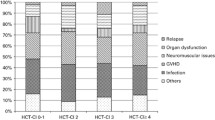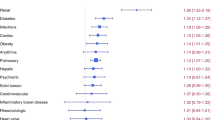Abstract
Patients who undergo autologous stem cell transplant (ASCT) for hematologic malignancies frequently have multiple comorbidities. The hematopoietic cell transplantation comorbidity index (HCT-CI), a transplant-specific modification of the Charlson comorbidity index, can predict risk of readmission following allogeneic stem cell transplant. Its utility in the autologous setting is unknown. We evaluated 620 patients who underwent ASCT at the Ohio State University from 2007 to 2012 for lymphoma or multiple myeloma (MM) to identify factors associated with readmission. Univariable and multivariable logistic regression were used to estimate the odds of readmission within 30 days of discharge following ASCT. A Cox proportional hazards model was used to evaluate OS. Sixty-four patients were readmitted within 30 days; the most common indications were fever and prolonged gastrointestinal toxicity. MM compared with lymphoma (odds ratio (OR) 1.89, 95% confidence interval (95% CI): 1.06–3.38, P=0.03), HCT-CI⩾3 (OR 1.74, 95% CI: 1.03–2.96, P=0.04) and length of hospitalization ⩾28 days (OR 3.14, 95% CI: 1.26–7.83, P=0.01) remained significantly associated with 30-day readmission in a multivariable model. While the model had excellent fit (P>0.75), its ability to predict individual patients who would be readmitted was less than acceptable (receiver-operator curve=0.64, 95% CI: 0.57–0.71). In a multivariable proportional hazards model, 30-day readmission (hazards ratio (HR) 1.81, 95% CI: 1.04–3.18, P=0.04), length of hospitalization ⩾28 days (HR 4.93, 95% CI: 2.65–9.18, P<0.001) and chemorefractory disease (HR 3.08, 95% CI: 1.74–5.43, P<0.001) were independently associated with inferior OS, but HCT-CI was not. Evaluation of other assessment tools may allow better prediction of outcomes following ASCT.



Similar content being viewed by others
References
Ashton CM, Kuykendall DH, Johnson ML, Wray NP, Wu L . The association between the quality of inpatient care and early readmission. Ann Intern Med 1995; 122: 415–421.
Ashton CM, Wray NP . A conceptual framework for the study of early readmission as an indicator of quality of care. Soc Sci Med 1996; 43: 1533–1541.
Ashton CM, Del Junco DJ, Souchek J, Wray NP, Mansyur CL . The association between the quality of inpatient care and early readmission: a meta-analysis of the evidence. Med Care 1997; 35: 1044–1059.
United States. Congress. House. Office of the Legislative Counsel, United States. Congress. House. Committee on Ways and Means, United States. Congress. House. Committee on Energy and Commerce, United States. Congress. House. Committee on Education and Labor. Compilation of Patient Protection and Affordable Care Act: as amended through November 1, 2010 including Patient Protection and Affordable Care Act health-related portions of the Health Care and Education Reconciliation Act of 2010. Government Printing Office: Washington, USA, 2010.
Charlson ME, Pompei P, Ales KL, MacKenzie CR . A new method of classifying prognostic comorbidity in longitudinal studies: development and validation. J Chronic Dis 1987; 40: 373–383.
Hasan O, Meltzer DO, Shaykevich SA, Bell CM, Kaboli PJ, Auerbach AD et al. Hospital readmission in general medicine patients: a prediction model. J Gen Intern Med 2010; 25: 211–219.
Capelastegui A, Espana Yandiola PP, Quintana JM, Bilbao A, Diez R, Pascual S et al. Predictors of short-term rehospitalization following discharge of patients hospitalized with community-acquired pneumonia. Chest 2009; 136: 1079–1085.
Chin MH, Goldman L . Correlates of early hospital readmission or death in patients with congestive heart failure. Am J Cardiol 1997; 79: 1640–1644.
Sorror ML, Maris MB, Storb R, Baron F, Sandmaier BM, Maloney DG et al. Hematopoietic cell transplantation (HCT)-specific comorbidity index: a new tool for risk assessment before allogeneic HCT. Blood 2005; 106: 2912–2919.
Bejanyan N, Bolwell BJ, Lazaryan A, Rybicki L, Tench S, Duong H et al. Risk factors for 30-day hospital readmission following myeloablative allogeneic hematopoietic cell transplantation (allo-HCT). Biol Blood Marrow Transplant 2012; 18: 874–880.
Jaing TH, Tsay PK, Yang CP, Hung IJ, Wen YC, Tseng CK . Evaluation of readmission in children receiving allogeneic hematopoietic stem cell transplantation: an institutional experience. Transplant Proc 2008; 40: 3643–3645.
Rauenzahn S, Truong Q, Cumpston A et al. Predictors and impact of thirty-day readmission on patient outcomes and health care costs after reduced-toxicity conditioning allogeneic hematopoietic cell transplantation. Biol Blood Marrow Transplant 2014; 20: 415–420.
Dungarwalla M, Brennan J, Kulkarni S, Saso R, Shaw B, Jennifer T et al. Duration of initial admission and subsequent readmission in the first 100 days following reduced intensity conditioning allogeneic stem cell transplantation. ASH Annu Meet Abstr 2007; 110: 1999.
Pasquini MC, Logan BR, Ho VT, McCarthy P, Cooke K, Rizzo J et al. Comorbidity index (CI) in autologous hematopoietic cell transplantation (HCT) for malignant diseases: validation of the HCT-CI. ASH Annu Meet Abstr 2012; 120: 814.
Lazaryan A, Bolwell B, Rybicki L, Reu F, Dean R, Duong H et al. The role of hematopoietic cell transplantation comorbidity index (HCT-CI) in autologous stem cell transplantation for multiple myeloma. Biol Blood Marrow Transplant 2012; 18: S254.
Tamari R, Dahi P, Devlin S, Goldberg J, Hamlin P, Matasar M et al. High dose therapy and autologous stem cell transplantation results in good outcomes and acceptable toxicities in elderly patients with non-Hodgkin’s lymphoma. Biol Blood Marrow Transplant 2013; 19: S133.
Wildes TM, Augustin KM, Sempek D, Zhang QJ, Vij R, Dipersio JF et al. Comorbidities, not age, impact outcomes in autologous stem cell transplant for relapsed non-Hodgkin lymphoma. Biol Blood Marrow Transplant 2008; 14: 840–846.
Hosmer DW, Lemeshow S . Applied Logistic Regression, 2nd edn Wiley: New York, NY, USA, 2000.
Gray RJ . A class of K-sample tests for comparing the cumulative incidence of a competing risk. Ann Statist 1988; 16: 1141–1154.
Cox DR . Regression models and life-tables. J R Statist Soc Ser B 1972; 34: 187.
Jantunen E, Canals C, Attal M, Thomson K, Milpied N, Buzyn A et al. Autologous stem-cell transplantation in patients with mantle cell lymphoma beyond 65 years of age: a study from the European Group for Blood and Marrow Transplantation (EBMT). Ann Oncol 2012; 23: 166–171.
El Cheikh J, Kfoury E, Calmels B, Thomson K, Milpied N, Buzyn A et al. Age at transplantation and outcome after autologous stem cell transplantation in elderly patients with multiple myeloma. Hematol Oncol Stem Cell Ther 4: 30–36.
Buadi FK, Micallef IN, Ansell SM, Porrata LF, Dispenzieri A, Elliot MA et al. Autologous hematopoietic stem cell transplantation for older patients with relapsed non-Hodgkin’s lymphoma. Bone Marrow Transplant 2006; 37: 1017–1022.
Hosing C, Saliba RM, Okoroji GJ, Popat U, Couriel D, Ali T et al. High-dose chemotherapy and autologous hematopoietic progenitor cell transplantation for non-Hodgkin’s lymphoma in patients >65 years of age. Ann Oncol 2008; 19: 1166–1171.
Lazarus HM, Carreras J, Boudreau C, Loberiza FR Jr, Armitage JO, Bolwell BJ et al. Influence of age and histology on outcome in adult non-Hodgkin lymphoma patients undergoing autologous hematopoietic cell transplantation (HCT): a report from the Center For International Blood & Marrow Transplant Research (CIBMTR). Biol Blood Marrow Transplant 2008; 14: 1323–1333.
Baker DW, Einstadter D, Husak SS, Cebul RD . Trends in postdischarge mortality and readmissions: has length of stay declined too far? Arch Intern Med 2004; 164: 538–544.
Jencks SF, Williams MV, Coleman EA . Rehospitalizations among patients in the Medicare fee-for-service program. N Engl J Med 2009; 360: 1418–1428.
Balla U, Malnick S, Schattner A . Early readmissions to the department of medicine as a screening tool for monitoring quality of care problems. Medicine (Baltimore) 2008; 87: 294–300.
Hansen LO, Young RS, Hinami K, Leung A, Williams MV . Interventions to reduce 30-day rehospitalization: a systematic review. Ann Intern Med 155: 520–528.
Rockwood K, Stadnyk K, MacKnight C, McDowell I, Hebert R, Hogan DB . A brief clinical instrument to classify frailty in elderly people. Lancet 1999; 353: 205–206.
Speechley M, Tinetti M . Falls and injuries in frail and vigorous community elderly persons. J Am Geriatr Soc 1991; 39: 46–52.
Acknowledgements
We thank Christina Bertram, Diane Scholl and Becky Whittaker for their work as disease-specific transplant coordinators for MM and lymphoma, as well as all of the staff involved in the care of our patients. This work is supported by the National Cancer Institute (1K12 CA133250). The authors have no financial conflicts of interest to disclose.
Author information
Authors and Affiliations
Corresponding author
Ethics declarations
Competing interests
The authors declare no conflict of interest.
Rights and permissions
About this article
Cite this article
Jaglowski, S., Ruppert, A., Hofmeister, C. et al. The hematopoietic stem cell transplant comorbidity index can predict for 30-day readmission following autologous stem cell transplant for lymphoma and multiple myeloma. Bone Marrow Transplant 49, 1323–1329 (2014). https://doi.org/10.1038/bmt.2014.155
Received:
Revised:
Accepted:
Published:
Issue Date:
DOI: https://doi.org/10.1038/bmt.2014.155
- Springer Nature Limited




